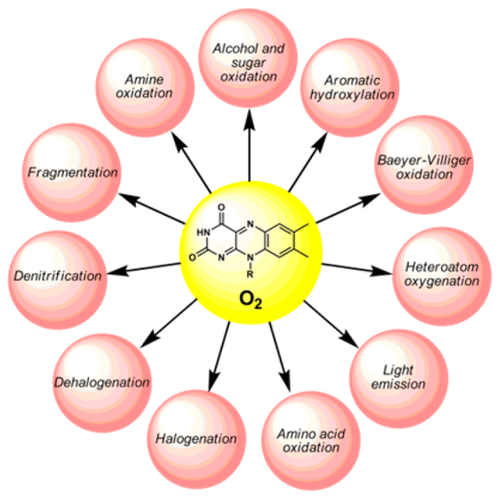当前位置:
X-MOL 学术
›
Chem. Rev.
›
论文详情
Our official English website, www.x-mol.net, welcomes your
feedback! (Note: you will need to create a separate account there.)
Same Substrate, Many Reactions: Oxygen Activation in Flavoenzymes
Chemical Reviews ( IF 51.4 ) Pub Date : 2018-01-11 00:00:00 , DOI: 10.1021/acs.chemrev.7b00650 Elvira Romero 1 , J. Rubén Gómez Castellanos 2 , Giovanni Gadda 3 , Marco W. Fraaije 1 , Andrea Mattevi 2
Chemical Reviews ( IF 51.4 ) Pub Date : 2018-01-11 00:00:00 , DOI: 10.1021/acs.chemrev.7b00650 Elvira Romero 1 , J. Rubén Gómez Castellanos 2 , Giovanni Gadda 3 , Marco W. Fraaije 1 , Andrea Mattevi 2
Affiliation

|
Over time, organisms have evolved strategies to cope with the abundance of dioxygen on Earth. Oxygen-utilizing enzymes tightly control the reactions involving O2 mostly by modulating the reactivity of their cofactors. Flavins are extremely versatile cofactors that are capable of undergoing redox reactions by accepting either one electron or two electrons, alternating between the oxidized and the reduced states. The physical and chemical principles of flavin-based chemistry have been investigated widely. In the following pages we summarize the state of the art on a key area of research in flavin enzymology: the molecular basis for the activation of O2 by flavin-dependent oxidases and monooxygenases. In general terms, oxidases use O2 as an electron acceptor to produce H2O2, while monooxygenases activate O2 by forming a flavin intermediate and insert an oxygen atom into the substrate. First, we analyze how O2 reaches the flavin cofactor embedded in the protein matrix through dedicated access pathways. Then we approach O2 activation from the perspective of the monooxygenases, their preferred intermediate, the C(4a)–(hydro)peroxyflavin, and the cases in which other intermediates have been described. Finally, we focus on understanding how the architectures developed in the active sites of oxidases promote O2 activation and which other factors operate in its reactivity.
中文翻译:

相同的底物,许多反应:黄素酶中的氧活化
随着时间的流逝,有机体已经进化出应对地球上大量双氧的策略。利用氧气的酶主要通过调节其辅因子的反应性来严格控制涉及O 2的反应。黄素是用途广泛的辅因子,通过接受一个或两个电子,在氧化态和还原态之间交替进行,能够进行氧化还原反应。黄酮类化学的物理和化学原理已得到广泛研究。在以下几页中,我们总结了黄素酶学研究的一个关键领域的最新技术水平:黄素依赖性氧化酶和单加氧酶激活O 2的分子基础。一般而言,氧化酶使用O 2作为一种电子受体,H 2 O 2产生H 2 O 2,而单加氧酶则通过形成黄素中间体将O 2活化并将氧原子插入底物中。首先,我们分析O 2如何通过专用的通路到达嵌入在蛋白质基质中的黄素辅因子。然后,从单加氧酶,其优选的中间体,C(4a)-(氢)过氧黄素以及描述了其他中间体的情况出发,我们研究了O 2活化。最后,我们着重于了解在氧化酶活性位点开发的体系结构如何促进O 2活化以及在其反应性中起作用的其他因素。
更新日期:2018-01-11
中文翻译:

相同的底物,许多反应:黄素酶中的氧活化
随着时间的流逝,有机体已经进化出应对地球上大量双氧的策略。利用氧气的酶主要通过调节其辅因子的反应性来严格控制涉及O 2的反应。黄素是用途广泛的辅因子,通过接受一个或两个电子,在氧化态和还原态之间交替进行,能够进行氧化还原反应。黄酮类化学的物理和化学原理已得到广泛研究。在以下几页中,我们总结了黄素酶学研究的一个关键领域的最新技术水平:黄素依赖性氧化酶和单加氧酶激活O 2的分子基础。一般而言,氧化酶使用O 2作为一种电子受体,H 2 O 2产生H 2 O 2,而单加氧酶则通过形成黄素中间体将O 2活化并将氧原子插入底物中。首先,我们分析O 2如何通过专用的通路到达嵌入在蛋白质基质中的黄素辅因子。然后,从单加氧酶,其优选的中间体,C(4a)-(氢)过氧黄素以及描述了其他中间体的情况出发,我们研究了O 2活化。最后,我们着重于了解在氧化酶活性位点开发的体系结构如何促进O 2活化以及在其反应性中起作用的其他因素。











































 京公网安备 11010802027423号
京公网安备 11010802027423号